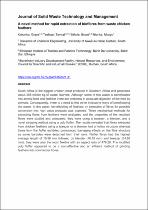JavaScript is disabled for your browser. Some features of this site may not work without it.
- ResearchSpace
- →
- Research Publications/Outputs
- →
- Conference Publications
- →
- View Item
| dc.contributor.author |
Kakonke, Grace

|
|
| dc.contributor.author |
Tesfaye, Tamrat

|
|
| dc.contributor.author |
Sithole, Bishop B

|
|
| dc.contributor.author |
Ntunka, M

|
|
| dc.date.accessioned | 2021-08-23T08:47:06Z | |
| dc.date.available | 2021-08-23T08:47:06Z | |
| dc.date.issued | 2021-02 | |
| dc.identifier.citation | Kakonke, G., Tesfaye, T., Sithole, B.B. & Ntunka, M. 2021. A novel method for rapid extraction of biofibres from waste chicken feathers. <i>Journal of Solid Waste Technology and Management, 47(1).</i> http://hdl.handle.net/10204/12093 | en_ZA |
| dc.identifier.issn | 1088-1697 | |
| dc.identifier.uri | https://doi.org/10.5276/JSWTM/2021.31 | |
| dc.identifier.uri | http://hdl.handle.net/10204/12093 | |
| dc.description.abstract | South Africa is the biggest chicken meat producer in Southern Africa and generates about 258 million kg of waste feathers. Although some of this waste is beneficiated into animal feed and fertiliser there are problems in adequate digestion of the feed by animals. Consequently, there is a need to find other innovative ways of beneficiating the waste. In this paper, beneficiating of feathers by extraction of fibres for possible conversion into high value products was explored. Three mechanical methods for extracting fibres from feathers were evaluated and the properties of the resultant fibres were studied and compared: they were using a tweezer, a blender, and a novel stripping method using a pulp fluffer. The results revealed that fibres extracted from chicken feathers using a tweezer or a blender had a hollow structure whereas those from the fluffer exhibited pronounced damaging effects on the fibre structure as some barbules were detached from their rami. Fluffer fibres had the highest average length of 16.56 mm followed by blender (16.15 mm) and tweezer (14.84 mm); they were also the most flexible with an aspect ratio of 476.29. The modified pulp fluffer appeared to be a cost-effective and an efficient method of grinding feathers into commercial fibres. | en_US |
| dc.format | Abstract | en_US |
| dc.language.iso | en | en_US |
| dc.relation.uri | https://www.ingentaconnect.com/content/jswt/jswt/2021/00000047/00000001/art00003 | en_US |
| dc.source | Journal of Solid Waste Technology and Management, 47(1) | en_US |
| dc.subject | Blenders | en_US |
| dc.subject | Chicken feathers | en_US |
| dc.subject | Fibres | en_US |
| dc.subject | Pulp fluffers | en_US |
| dc.title | A novel method for rapid extraction of biofibres from waste chicken feathers | en_US |
| dc.type | Article | en_US |
| dc.description.pages | 31-45 | en_US |
| dc.description.note | Copyright: 2021 Ingenta. Due to copyright restrictions, the version attached is the abstract copy only. For access to the full text version, please consult the publisher's website: https://www.ingentaconnect.com/content/jswt/jswt/2021/00000047/00000001/art00003 | en_US |
| dc.description.cluster | Chemicals | en_US |
| dc.description.impactarea | Biorefinery Industry Developme | en_US |
| dc.identifier.apacitation | Kakonke, G., Tesfaye, T., Sithole, B. B., & Ntunka, M. (2021). A novel method for rapid extraction of biofibres from waste chicken feathers. <i>Journal of Solid Waste Technology and Management, 47(1)</i>, http://hdl.handle.net/10204/12093 | en_ZA |
| dc.identifier.chicagocitation | Kakonke, Grace, Tamrat Tesfaye, Bishop B Sithole, and M Ntunka "A novel method for rapid extraction of biofibres from waste chicken feathers." <i>Journal of Solid Waste Technology and Management, 47(1)</i> (2021) http://hdl.handle.net/10204/12093 | en_ZA |
| dc.identifier.vancouvercitation | Kakonke G, Tesfaye T, Sithole BB, Ntunka M. A novel method for rapid extraction of biofibres from waste chicken feathers. Journal of Solid Waste Technology and Management, 47(1). 2021; http://hdl.handle.net/10204/12093. | en_ZA |
| dc.identifier.ris | TY - Article AU - Kakonke, Grace AU - Tesfaye, Tamrat AU - Sithole, Bishop B AU - Ntunka, M AB - South Africa is the biggest chicken meat producer in Southern Africa and generates about 258 million kg of waste feathers. Although some of this waste is beneficiated into animal feed and fertiliser there are problems in adequate digestion of the feed by animals. Consequently, there is a need to find other innovative ways of beneficiating the waste. In this paper, beneficiating of feathers by extraction of fibres for possible conversion into high value products was explored. Three mechanical methods for extracting fibres from feathers were evaluated and the properties of the resultant fibres were studied and compared: they were using a tweezer, a blender, and a novel stripping method using a pulp fluffer. The results revealed that fibres extracted from chicken feathers using a tweezer or a blender had a hollow structure whereas those from the fluffer exhibited pronounced damaging effects on the fibre structure as some barbules were detached from their rami. Fluffer fibres had the highest average length of 16.56 mm followed by blender (16.15 mm) and tweezer (14.84 mm); they were also the most flexible with an aspect ratio of 476.29. The modified pulp fluffer appeared to be a cost-effective and an efficient method of grinding feathers into commercial fibres. DA - 2021-02 DB - ResearchSpace DP - CSIR J1 - Journal of Solid Waste Technology and Management, 47(1) KW - Blenders KW - Chicken feathers KW - Fibres KW - Pulp fluffers LK - https://researchspace.csir.co.za PY - 2021 SM - 1088-1697 T1 - A novel method for rapid extraction of biofibres from waste chicken feathers TI - A novel method for rapid extraction of biofibres from waste chicken feathers UR - http://hdl.handle.net/10204/12093 ER - | en_ZA |
| dc.identifier.worklist | 24876 | en_US |






